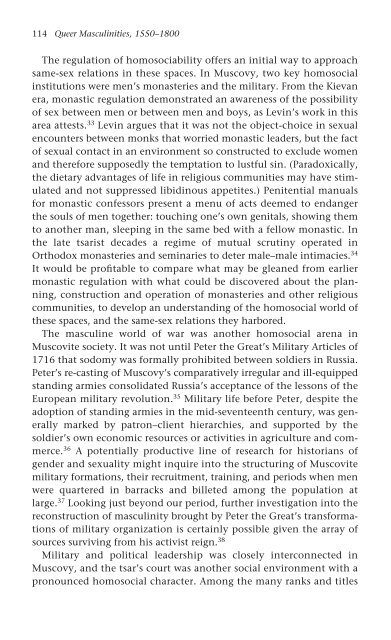queer masculinities
queer masculinities
queer masculinities
Create successful ePaper yourself
Turn your PDF publications into a flip-book with our unique Google optimized e-Paper software.
114 Queer Masculinities, 1550–1800<br />
The regulation of homosociability offers an initial way to approach<br />
same-sex relations in these spaces. In Muscovy, two key homosocial<br />
institutions were men’s monasteries and the military. From the Kievan<br />
era, monastic regulation demonstrated an awareness of the possibility<br />
of sex between men or between men and boys, as Levin’s work in this<br />
area attests. 33 Levin argues that it was not the object-choice in sexual<br />
encounters between monks that worried monastic leaders, but the fact<br />
of sexual contact in an environment so constructed to exclude women<br />
and therefore supposedly the temptation to lustful sin. (Paradoxically,<br />
the dietary advantages of life in religious communities may have stimulated<br />
and not suppressed libidinous appetites.) Penitential manuals<br />
for monastic confessors present a menu of acts deemed to endanger<br />
the souls of men together: touching one’s own genitals, showing them<br />
to another man, sleeping in the same bed with a fellow monastic. In<br />
the late tsarist decades a regime of mutual scrutiny operated in<br />
Orthodox monasteries and seminaries to deter male–male intimacies. 34<br />
It would be profitable to compare what may be gleaned from earlier<br />
monastic regulation with what could be discovered about the planning,<br />
construction and operation of monasteries and other religious<br />
communities, to develop an understanding of the homosocial world of<br />
these spaces, and the same-sex relations they harbored.<br />
The masculine world of war was another homosocial arena in<br />
Muscovite society. It was not until Peter the Great’s Military Articles of<br />
1716 that sodomy was formally prohibited between soldiers in Russia.<br />
Peter’s re-casting of Muscovy’s comparatively irregular and ill-equipped<br />
standing armies consolidated Russia’s acceptance of the lessons of the<br />
European military revolution. 35 Military life before Peter, despite the<br />
adoption of standing armies in the mid-seventeenth century, was generally<br />
marked by patron–client hierarchies, and supported by the<br />
soldier’s own economic resources or activities in agriculture and commerce.<br />
36 A potentially productive line of research for historians of<br />
gender and sexuality might inquire into the structuring of Muscovite<br />
military formations, their recruitment, training, and periods when men<br />
were quartered in barracks and billeted among the population at<br />
large. 37 Looking just beyond our period, further investigation into the<br />
reconstruction of masculinity brought by Peter the Great’s transformations<br />
of military organization is certainly possible given the array of<br />
sources surviving from his activist reign. 38<br />
Military and political leadership was closely interconnected in<br />
Muscovy, and the tsar’s court was another social environment with a<br />
pronounced homosocial character. Among the many ranks and titles


